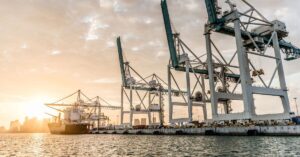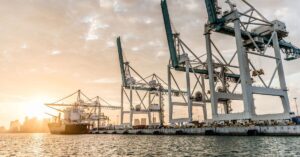
Ship Management Company Fined $1.75M For Falsifying Oil Records & Illegal Discharges At Sea
November 4, 2024
Watch: Israeli Commandos Capture Hezbollah Naval Officer In Large-Scale Seaborne Raid In Lebanon
November 4, 2024

Weifang Port in Shandong has made history as China’s first port to officially achieve carbon neutrality. This certification, issued on October 15 by the China Classification Society Quality Certification Company, recognizes the country’s efforts to decarbonize the global shipping sector.
The port’s zero-carbon status mainly was obtained by shifting away from fossil fuels. According to China Electric Power News (CEPN), Weifang Port has installed a wind power system to supply green energy for its operations, and it has also introduced hydrogen-powered vehicles to replace traditional fossil-fuel trucks.
The port obtains certified carbon credits for emissions that cannot be avoided, guaranteeing that it has a zero-carbon footprint even during peak operational times.
Globally, the shipping industry is responsible for around 3% of greenhouse gas emissions, with ports having a major part in this figure. According to Yicai, a leading financial news outlet, the concept of zero-carbon ports is gaining support in China’s transportation sector.
Tianjin Port has announced the development of the world’s first smart zero-carbon terminal, and Huangshi New Port has successfully integrated a zero-carbon power plant into its operations.
Huanghua Port also launched China’s first zero-carbon coal terminal pilot project. However, Weifang Port stands out as the first to receive this designation for an entire port.
Despite these achievements, experts warn that decarbonizing shipping poses major challenges.
As port activity expands, so does energy consumption, and many ports face technological and policy challenges that obstruct their zero-carbon initiatives.
Wang Nini, a researcher at the Water Transport Science Research Institute under China’s Ministry of Transport, said centralized port management provides more chances for carbon reduction than land transport.
However, challenges like inadequate spatial planning and unused shorelines limit the implementation of sustainable energy options.
Additionally, while ports slowly shift to renewable energy sources such as wind and solar, many face difficulties due to site conditions. Some ports lack adequate room for solar power installation or have outdated equipment that impedes the efficient use of renewable energy.
Jiang Mengnan, Dialogue Earth’s strategic communications officer, discussed the need to upgrade these systems to support ongoing efforts in the shipping sector.
Reference: Infomarine
Weifang Port Becomes China’s First Official Carbon-Neutral Port appeared first on Marine Insight – The Maritime Industry Guide
Source: Maritime Shipping News


